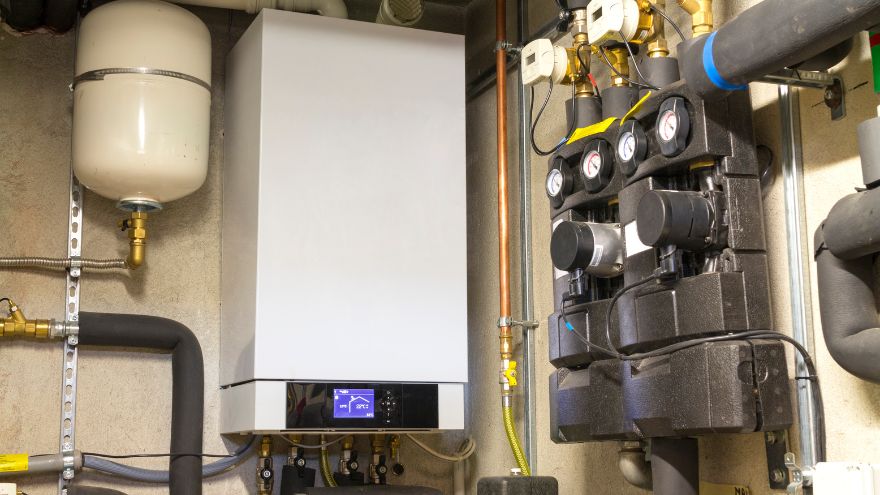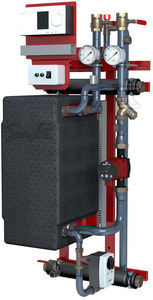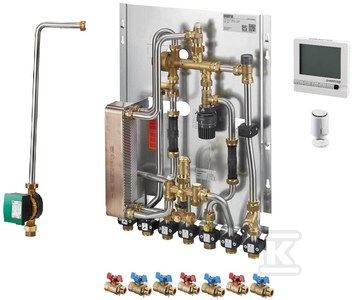Optimal thermal comfort is important, but achieving it requires proper preparation of the entire installation and system. One of the solutions is to use a heating substation. What exactly is a heating substation and what variants should be distinguished? How to optimally create and configure a heating substation?

Check out the heating stations at the Onninen wholesaler
What is a heating substation?
A heating substation is a place that connects installations or target devices with the external network. A characteristic feature of the node is that within it it is possible to change the parameters or change the type of heat carrier supplied from the connection. The node also helps to easily adjust the amount of heat supplied. An example of a heating node is a connection of a central heating installation located e.g. inside a building with an external system, such as a heating network.
To achieve optimal operation of the system, you need to know what functions it is supposed to perform. The main task is to deliver heat from the network to the installation and its appropriate transformation. In addition, this system also allows for precise energy consumption measurements, on the basis of which payment settlements for individual installations are prepared.
A properly configured heating node also allows you to automate the regulation of temperature and pressure inside individual circuits.
Types of heating substations
In practice, heat distribution centers are a very broad issue, which is why specialists make quite detailed classifications. One of the most important criteria is the way in which the external heating network installation is connected to the one located inside the building. This option includes two variants: direct-acting and exchanger nodes. The difference between them is that in the first solution, both the network and the installation contain the same factor, while the characteristic feature of the second variant is that the heat exchanger connects two separate, independent circuits.
 Additionally, it is worth noting that in direct nodes there are systems in which the parameters of the factor do not change and those in which it is necessary to use a hydroelevator and a pump to change the parameters.
Additionally, it is worth noting that in direct nodes there are systems in which the parameters of the factor do not change and those in which it is necessary to use a hydroelevator and a pump to change the parameters.
Another division is to take into account the number of heated buildings. If one object is serviced, it is referred to as an individual node, while otherwise it is a group node. However, taking into account the number of installations connected to the node, there are single-function and multi-functional models, most often it is a dual-function node.
Taking into account the type of functions they perform, heat nodes are divided into central heating, hot water and process heat nodes. Within DHW, we can also distinguish 1- and 2-stage systems (they indicate the number of zones in which hot water is prepared).
Selection of the power of the heating node in the block
Heat substations are an excellent solution that allows for effective management and control of parameters to achieve optimal thermal comfort in the facility. This issue is particularly important in apartment blocks and other multi-family buildings, where an appropriate level of heating must be provided to all residents.
 In order to know how to properly select the power of a heating substation to suit the needs of a given facility, you must understand how it is constructed and what elements it consists of. You should know that individual solutions may differ from each other, but the most typical systems use: a heat exchanger, a circulation pump, valves, filters and a heat meter (heat meters), which are the basis for settlements for individual premises. In a multi-family building, the thermal needs of the building are different than in a single-family house, which should be taken into account when designing and implementing the project.
In order to know how to properly select the power of a heating substation to suit the needs of a given facility, you must understand how it is constructed and what elements it consists of. You should know that individual solutions may differ from each other, but the most typical systems use: a heat exchanger, a circulation pump, valves, filters and a heat meter (heat meters), which are the basis for settlements for individual premises. In a multi-family building, the thermal needs of the building are different than in a single-family house, which should be taken into account when designing and implementing the project.
Before installing the appropriate variant, you should carefully consider the power of the node, which is calculated based on the formula. The factors that are important for obtaining a reliable result are the amount of heat delivered/received in a specific time period.
Is it better to choose a single-function or dual-function heating station?
When planning the construction of a heating substation, many decisions must be made, including whether single-function heating substations or two-function heating substations will be better. Each solution has specific advantages and disadvantages, which are best analyzed individually. A characteristic feature of the single-function variant is that it has only one heat exchanger. In practice, this means that the system allows, for example, to heat water only in the heating system. They are simple in construction and their dimensions are extremely compact. For this reason, these solutions are cheaper than other models.
Despite the higher price , the dual-function heating unit is very popular. When choosing this variant, what matters most is the advantages of this solution. The devices that make up the system not only allow you to heat water in the heating system, but also provide access to hot water. This effect can be achieved because two separately operating heat exchangers are used. Owners of dual-function units can use this variant at any time of the year - in winter, both the needs of heating the apartment and access to hot water are met, while in the summer - it is a great way to gain constant access to water.
Heat distribution centers in the Onninen wholesaler
The Onninen hydraulic wholesaler offers various types of devices that allow for comprehensive construction of the entire heating plant, as well as excellent quality heat pumps, thanks to which proven, solid and durable models are used to produce heat. This way, the temperature is optimal, the heating is efficient, and none of the residents will feel cold.
The offer includes, among others: ready-made systems, such as the Danfoss heating plant , which is a technically advanced solution that allows for high and effective integration of individual system elements. The proposal is a comprehensive solution that is easy to install and maintain.
Heat in the apartment, but also hot water, can be obtained thanks to dual-function models. Even though they are more expensive, their use has many advantages. An example is, among others, Oventrop CWU WBASIC12-C heating station . The offer also includes other models, including: with a flow of 15 l/min and 17 l/min.